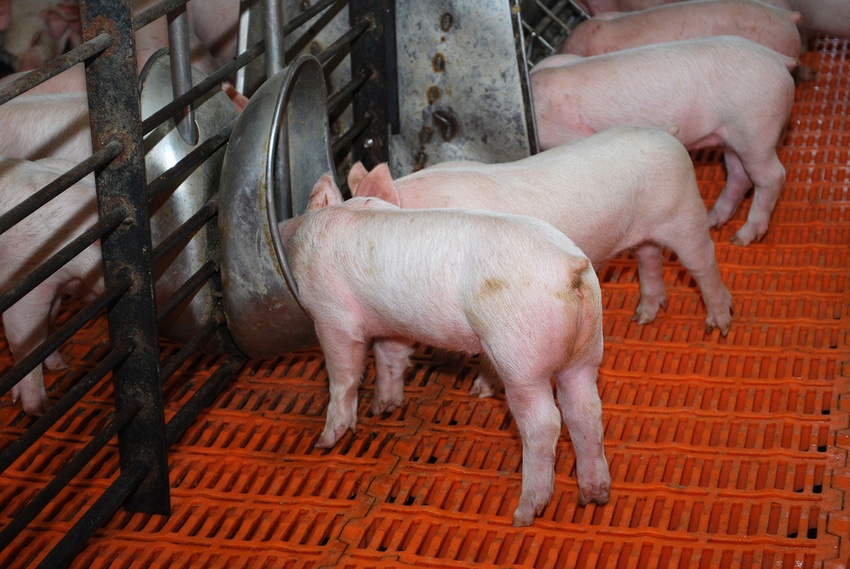Zinpro unveils new water-soluble zinc product
Oklahoma State University researchers found pigs receiving 40 ppm of the water-soluble zinc were 1.5 pounds heavier at Day 21 and 2.89 pounds heavier at Day 42 than pigs fed the control diet.

A global leader in performance trace mineral nutrition has discovered a way to convert zinc into a water-soluble form and an opportunity to get nutrients into those stressed, shipped piglets who will often choose to drink rather than eat when they arrive at their destination.
“Generally, they will find water before they will find feed,” says Wesley Schweer, a swine nutritionist for Zinpro. “Water intake is going to drive feed intake so this creates an opportunity to provide nutrients to aid with piglet gut health, piglet immunity, all of that is going to culminate in improvement in performance and we have that opportunity to do that through a water program in the nursery.”
According to Schweer, TruCare LQ Zn is the first and only research-validated, cold water-soluble zinc available on the market. Available in a 200-gram packet, the product dissolves into 2 gallons of stock solution water, resulting in an optimal 40 parts per million solution when run through a 1:128 dilution.
In research with Oklahoma State University, the water-soluble zinc was tested on 280 crossbred pigs (5.6 kg birth weight) from seven different sow farms. Pigs were randomly assigned to one of four water treatments: zero ppm (control diet), 20 ppm, 40 ppm or 80 ppm of zinc (TruCare LQ Zn) per liter of water. Pigs were fed a common non-medicated diet with growth promoting levels of inorganic zinc oxide and inorganic copper sulfate: 2,500 ppm of zinc oxide for Days 1 to 7, 1,750 ppm of zinc oxide for Days 8 to 14, and 200 ppm of copper sulfate for Days 14 to 42.
The pigs and feeders were weighed weekly to determine average daily gain, average daily feed intake and gain-to-feed ratio. Water meters were used to record and calculate average daily water intake.
Researchers found that the pigs receiving the 40 ppm of the water-soluble zinc were 1.5 pounds heavier at Day 21 and 2.89 pounds heavier at Day 42 than pigs fed the control diet.
Since the longer the piglet goes without feed or is under stress, the more opportunities for opportunistic bacteria to disrupt gut health and integrity, Zinpro then worked with the University of Minnesota to research how the product impacts the immune outcomes when piglets were challenged with Lawsonia intracellularis, which causes ileitis in the pig.
Pigs were fed one of three diets: 125 ppm of zinc sulfate in the feed (control diet), 125 ppm of total zinc with 50 ppm from zinc amino acid complex (Availa Zn) in the feed and 125 ppm of zinc sulfate in the feed and 40 ppm of water-soluble zinc (TruCare LQ Zn) in the water. Pigs received these treatments for 21 days prior to being exposed to a subclinical Lawsonia intracellularis challenge on Day 21. Pigs were serial sacrificed at 14, 21 and 28 days post-inoculation to measure the host immune response to the challenge.
Through that study, researchers discovered that the pigs receiving zinc in the water developed antibodies up to one week earlier than challenged pigs receiving zinc sulfate. T cell counts in the infected crypts of the ileum of pigs fed the control diet remained suppressed at 21 days post-inoculation compared to pigs fed the zinc amino acid complex which showed increased T cell counts. At 28 DPI, pigs receiving the water-soluble zinc had fewer intestinal lesions caused by LI and the lesions were less severe than pigs receiving nutritional levels of Zn sulfate.
Schweer says, although Zinpro has not tested every water application available for nursery pigs, research has shown the product does not interfere with water applications they have already tested, such as vaccines, antibiotics, acidifiers, etc., the producer may be using.
In addition to these results, the swine nutritionist says through improved gain, the producer should also see benefits in lower feed costs, reduced labor expenses and more efficient throughput through the finisher.
“There’s a premium on gain and if we increase gain, we reduce our days to market,” Schweer says. “If we increase our nursery exit weights, that has a profound impact on how long it takes that animal to reach market weight.”
About the Author(s)
You May Also Like





